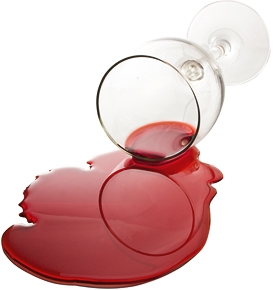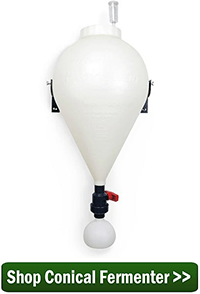 I bought two wine making kits from you that makes 6 gallons (30 bottles). Last night we bottled the first wine and got 25 bottles. Is this about right considering you do lose some during racking? Approximately how much waste do you normally have due to sediments in the bottom?
I bought two wine making kits from you that makes 6 gallons (30 bottles). Last night we bottled the first wine and got 25 bottles. Is this about right considering you do lose some during racking? Approximately how much waste do you normally have due to sediments in the bottom?
Mary M
—–
Hello Mary,
While there will be some waste, there should be nothing close to the five bottles you lost on your first batch. You should be losing no more than one bottle when making wine from with a wine ingredient kit. This is a common issue among beginning winemakers who are just learning how to make your own wine. It’s also an issue that brings up a great wine making tip.
Most of the wine that is being lost, is being lost unnecessarily during the racking process. Racking means to transferring the wine off the sediment into a clean fermentation vessel. This is a process that is normally done three times if you are following the directions that typically come with a wine ingredient kit.
It’s only natural for the first-time winemaker to want to leave as much sediment behind as possible with each racking. The intentions are good, but the result is an excessive loss of wine, such as what you have experienced.
 To get the most wine out of every batch, you want to get as much of the wine as possible during the first two rackings, even if it means some sediment is coming along with it. You will still be leaving 95% of the sediment behind. It is only when you get down to the all-important, last racking that you will want to lose some of the wine because of sediment.
To get the most wine out of every batch, you want to get as much of the wine as possible during the first two rackings, even if it means some sediment is coming along with it. You will still be leaving 95% of the sediment behind. It is only when you get down to the all-important, last racking that you will want to lose some of the wine because of sediment.
What you will find is by the time you get to the last racking there will be so little sediment in the fermenter that there will be very little loss by leaving it all behind.
If you stick to this method of racking your wine you will be pleasantly surprised by the results. It’s more wine, and it’s less hassle.
Happy Wine Making,
Ed Kraus
—–
Ed Kraus is a 3rd generation home brewer/winemaker and has been an owner of E. C. Kraus since 1999. He has been helping individuals make better wine and beer for over 25 years.

At times at the first racking when I have a great deal of sediment I will put all of the sediment into a glass gallon jug. I place the jug in a cool or refrigerated space and allow it to settle. At times I have reclaimed close to 3/4ths of a quart. Then this small amount of wine is used for topping off. This has worked well for me.
Nice response Joe.. I hope many are ready your comments. It is good take all of the sediment into a tall bottle..refridgerated helpseiment to fall out.. also put a 1/4 in dowel on the siphon hose.. attack with 2 zip ties. One at top. About 3 ft long..then pull the dowel down 1/4 inch below siphon tube..siphon.. near the end…about 1 inch of wine left..tip te bottle being siphoned from over a bit.. thus juice is deeper. Let it finish..about 1-2 ounces of wine left.. I rack 5-6 times before bottling. Sometimes more.but the key is very cold wine before racking.. hope this helps..
I agree with using the method in this blog. By the time you get to the last racking there is very little sediment. I do admit that the first couple times I also sacrificed wine because it started coming out a little cloudy. Experimentation is the best education.
Terry, if you use the method in this blog post you will not have any sediment in the final wine and you will have all the wine to boot. As far as your Chianti goes, the reason it is sweet is because the fermentation did not complete. It has nothing to do with quality, etc.. In the future, you will want to check you wines with a hydrometer to confirm that the fermentation has completed before going on to the next step.
I have never gotten more than 26 bottles per batch. I prefer to lose a bottle or two than to have sediment in my the wine.
I also have a question on the Chianti that I’ve made more than a year ago.
The chianti is very sweet. Is it because i didn’t top off the fermenter with water?
Or is it because I bought a lesser quality wine?
Thank you!
Are you using a racking cane? I use one every time I rack my wine and then for bottling. The amount of sediment that is picked gets smaller with each racking. Just make sure you don’t move the cane around. Keep it in one spot on the bottom. When I bottle I have no noticable sediment in my bottles and i get the 30 bottles almost every time.
Seems more likely to me that she did not start with 6 gallons of must. You would have to leave behind a heck of a lot of dregs to lose 5 bottles which is about a whole gallon!
Tip your fermenter away from you before you begin the siphon, a 2×4 scrap under the side closest to you is about right. Then cut a couple of slots in the cap on your racking cane about 3/16″ wide and about 3/4 the way down or with the cap removed from the racking cane just drill a 3/16″ hole all the way through across the cap centered up and down. When you siphon the first time you will pull a lot of sediment for the first few seconds then it will settle down. You will notice that the wine will make a little hole in the sediment around the racking cane , but not pull sediment from more than say 1/2″-3/4″ around the racking cane. This way you can get almost every drop of wine and very little sediment. By the last racking there should only be a dusting on the bottom of the carboy, so you won’t be pulling any sediment until the last few ounces of liquid.
I use 1/4 inch siphoning hose to siphon my 5 gallons of wine. I cut two small V notches on the end of it, so when I push the hose down the side of my pail, the open end will bow up against the side of the pail and not flat on the bottom. The V notches I cut with a nail clipper, will be at the top edge of the hose as it is pressed against the side of the pail. Even from my very first siphoning I pick up almost no sediment from the bottom that way, and I lose almost no wine at all that is worth worrying about. And I almost never have to siphon more than twice before I bottle in one gallon jugs to age and clear for three or four months before I siphon the third and finial time. P.S. I also set my pail on a chair during fermentation and never move it again until after it is siphoned.
Slow siphoning sucks up less sediment than fast siphoning, so position your supply carboy no higher above your receiving carboy than necessary. At the end of racking the level of wine in the receiving carboy should be just a little below the bottom of the supply carboy.
My wine when completed and bottled will have a Fizz when you pour a glass of wine from any bottle similar to like champagne what causes this it does not affect the quality of the wine, in fact, some say they like
These are all great ideas and speak to the tinkerer in me of figuring out a more efficient and sometimes unique way.
I have moved to using plastic buckets, with spigots/valves at the base, for the first two to three rackings. It’s SO easy to just drain the bucket into the next one, without any other equipment, with very little splashing, and with very little sediment disruption. The opening in the base is about an inch off the bottom, so you can get just about all the must out and then tip the container gently to get out the remaining amount. They are easy to clean since they have large openings at the top, and the spigot valves are easy to clean and sanitize as well. I also use nitrogen gas in the tops of the buckets, so draining the must doesn’t break the protective layer at the top of one, and the must going to the next just displaces the air in the container as it fills.
I have racked into a glass carboy for the final racking, and have the carboy in a milk crate for easy movement. I plan on using a vacuum method for filling bottles.
Thanks again everyone~ great suggestions!
David
I am new to winemaking. I have just made my first batch (5 gal) of Plum wine from home grown Santa Rosa plums. I did not syphon the primary fermenter correctly, and hand pumped the liquid into at 5 gal carboy. I also pumped out all of the liquid, which meant that I extracted all of the sediment that fell to the bottom of the bucket during primary fermentation. I am a week into the transfer from the primary fermenter into the carboy.
My question is do I rack now? If I wait until secondary fermentation is over (3-5 wks), am I exposing the wine to certain risks? Or are there even possible benefits to leaving the wine in contact with the excess sediment during secondary fermentation? Do the costs exceed the potential benefits or vice versa? Thanks in advance.
Steve, if there is a lot of sediment, I would get the wine off of it. Leaving the wine sitting on sediment too long can cause off flavors in the wine. Most of the off-flavors stem from the fact that some of the active yeast cells will try to consume the dead yeast cells the lie at the bottom as the sugar starts to run out. This is a process known as autolysis. For more information, please take a look at the article provided below.
Racking Wine
https://blog.eckraus.com/why-rack-wine-to-secondary
If there is a sediment in the wine, How to filter it out to get wine out of it,
I use fine filter colths to do the filter. Is there a better way to do it
Sudhir, the sediment should be dropping to the bottom of the fermenter. Each time you rack the wine you will be leaving most of that behind. When it comes to the final racking, you will leave all of the sediment behind at the expense of a little wine. For more information, please see the article posted below.
How To Handle Last Bit Of Sediment
https://blog.eckraus.com/sediment-wine-removing